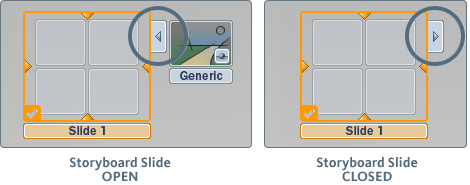Show in Contents

Add to Favorites

Home: Autodesk Showcase Help

View a storyboard

Set up and view a storyboard

Organize storyboard slides

Set up a storyboard
This feature is available
only in Autodesk Showcase Professional.
Create an empty slide
Do one of the following:
- Click Presentation > Create Storyboard
Slide. The new slide is added to the storyboard.
- Right-click an existing slide, then choose Insert from
the menu that pops up. The new empty slide will be created to the
left of the slide you clicked on.
- Click the Create button
on the Storyboard interface. The new slide is added to the storyboard.
In all cases, the newly
created slide is empty and has a default duration of 3 seconds.
Add scene items to a slide
You can add individual
items (alternatives, shots, or one environment) to an empty slide
or to a slide that already has items in it.
To add a scene item to
a slide:
- If the slide to which you want to add
an item already exists, make sure that slide is current (click it);
otherwise go to the next step.
The current slide has a checkmark in the lower
left corner of the slide.
- Open the interface that displays the
item you want to add (for example, press E for the
Environments interface).
- Right-click the item you want to add
to the slide and select Add to Current Storyboard Slide (or Add
to New Storyboard Slide if no slides currently
exist) from the menu that appears. The item is added to the current
slide.
NoteWhen adding items with
a duration such as Shots or animated Behaviors, the Slide Duration
will be extended to contain that item’s duration if it isn’t long
enough.
Add behaviors to a slide
You
can add a behavior to an empty slide or to a slide that already
has items in it. The playback action of the behavior is set when
adding to the slide.
To add a behavior to
a slide:
- If the slide to which you want to add
an item already exists, make sure that slide is current (click it);
otherwise go to the next step.
The current slide has a checkmark in the lower
left corner of the slide.
- Open the Behaviors interface.
- Right-click the behavior you want to
add to the slide and select Add to Current Storyboard
Slide (or Add to New Storyboard
Slide if no slides currently exist) from the
menu that appears.
A sub-menu
appears with various playback actions:
- Select a playback action for the behavior
when it is triggered by playing the slide.
The playback actions are:
Change a behavior playback
action within a slide
If a slide has a behavior
in it, an arrowed tab is attached to the upper right outside of
the tab. When the slide is opened, you can see the icons for any
behaviors triggered for playback by the slide, and each icon will
indicate the playback method in the upper right corner.
To change a behavior playback action in a slide:
- Open the slide by clicking on the arrowed
tab in the upper right of the slide icon.
- Right-click over the behavior in the
slide you wish to edit, and select Change action to... from
the menu.
A sub-menu
appears with various playback actions (see
Add behaviors to a slide).
- Select a new playback action for the
behavior in that slide.
Associate a hotkey with
a storyboard slide
Right-click
the slide (it must have an item added to it), select Set
Key, then select a hotkey combination from the Key pull-down
menu in the Hotkey Editor.
Associated hotkeys are
shown in the Storyboard interface.
Associate a 3D trigger
with a storyboard slide
Right-click
the slide (it must have an item added to it), select Associate
Trigger, then select a trigger from the submenu.
Slides with triggers
associated are shown in the Storyboard interface with an icon in
the upper left corner.
View items in a slide
If
a slide has something in it, an arrowed tab is attached to the upper
right outside of the tab. When the slide is opened, you can see
all the different elements in it: alternatives, environments, behaviors,
and shots, or any combination of these.
To open a slide, click
the arrowed tab attached to the upper right outside of the slide.
To close it, click on the tab again.
Delete items in a slide
To delete an item from
a slide:
- Open
the slide by clicking on the arrowed tab in the upper right of the
slide icon.
- Right-click over the item in the slide
you wish to delete, and select Delete from
the menu.
The item will be removed from the Storyboard slide.
Edit the properties of
items in a slide
To open the properties of editable items in
a slide:
- Open the slide by clicking on the arrowed
tab in the upper right of the slide icon.
- Right-click over the item in the slide
you wish to edit, and select Properties from
the menu.
The Properties window
for that item will open.
NoteAlternatives
and some environments do not have editable properties, so the Properties
menu item will either be greyed out or not available.
Save a storyboard
A storyboard is automatically saved when you
save the scene.
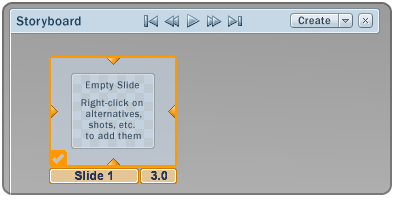
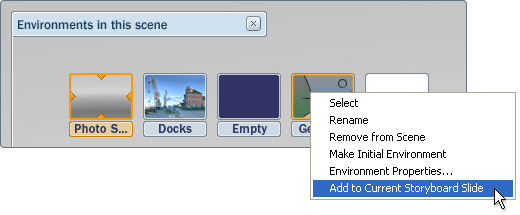
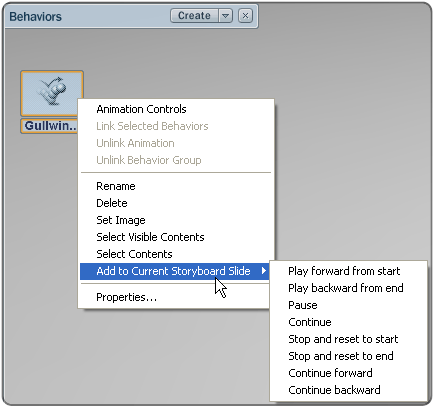
![]()

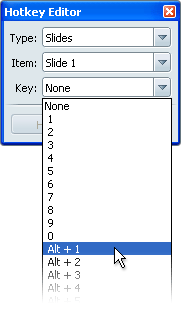
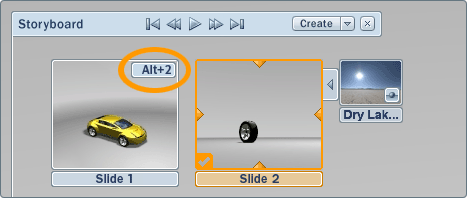
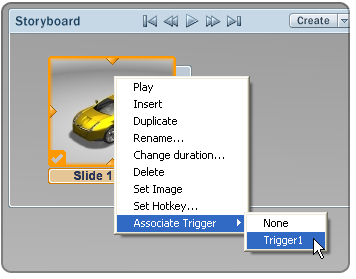
![]()
